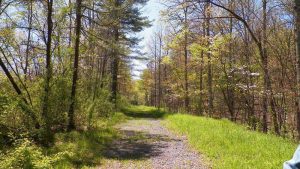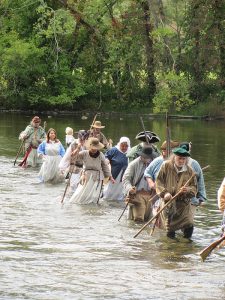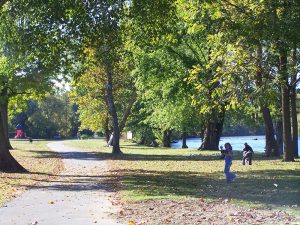Communities see opportunity in new trails
By Lorelei Goff
Besides solitude, exercise, adventure and a connection to nature, hiking trails offer opportunities for ecotourism. Like the networks of people who help maintain them and provide logistical support for long-distance hikers, it takes a network of private and public partnerships to create them. Here’s a look at a few efforts to bring more trails — and dollars — to rural Appalachian communities.
C&O Railroad Trail

The former railroad right of way provides a level path for future hikers along the C&O Railroad Trail. Photo by Debbi Hale
When Debbi Hale steps onto the remnants of the C&O railroad bed at the base of Pine Mountain in Pound, Va., the first thing she sees is the old tunnel the company blasted through the mountain to Jenkins, Ky., in 1947. She walks up to its yawning mouth where timbers buttress the fault-riddled rock and listens to its curious groans as the fog drifts in and out.
Hale turns away to the east, following the old railroad bed through a gash in the mountain. She walks on, passing wetlands, some old growth forest and vestiges of fields, stopping just shy of the North Fork of Pound Lake at the old Wright cemetery, the resting place of infamous Pound resident Devil John Wright. Wright was alleged to have killed as many as 27 men, including the namesake of the nearby Red Fox Trail.
For the last four years, Hale, a teacher and native of Pound, has worked to make this 3-mile section of the old railroad into a Forest Service trail connecting the 1.15-mile historic Red Fox Trail to the 110-mile Pine Mountain Trail in Kentucky, which is part of the long-distance, multi-state Great Eastern Trail.
What: A historic trail open to hiking, biking and horses that would connect to the C&O Railroad Trail
Where: Near Pound, Va. From Pound, take Hwy. 23 North for 3.6 miles, turn left on SR 667 for .6 miles, park in graveled area on the right side of SR 667. Cross road on foot, pass through Forest Service gate, and follow road bed to the left for .17 miles before trailhead.
Distance: 1.15 miles
Difficulty: Moderate
Contact: Clinch Ranger District at
276-679-8370
Visit: tinyurl.com/redfoxtrail
Since most of the treadway is already in place — the railroad company removed the tracks when the right of way reverted back to the Forest Service and private landowners — her biggest challenge was identifying the current landowners. All the parties must sign a land use agreement detailing how and by whom the trail will be maintained. The agreement also relieves landowners of liability for the trail under Virginia state law. So far, all but two landowners have signed.
She began the project as a way to stimulate the faltering local economy, and she hopes the town will become an officially designated Trail Town. The Cloudsplitter 100, a 100-mile trail race on Pine Mountain that incorporates part of the proposed trail, brought more than 100 visitors to the town of roughly 1,000 last year. The number could more than double this year since the event will be a qualifier for a prestigious European trail race. Meanwhile, Hale continues to advocate for the trail and for reopening the tunnel that connects it with Jenkins, Ky.
Overmountain Victory National Historic Trail
Autumn had just begun to steal the summer green from the slopes of Southern Appalachia on Sept. 24, 1780, when militiamen — farmers, blacksmiths, coopers and the like — marched southeast from the Muster Grounds in Abingdon, Va., to meet the British Army at the Battle of Kings Mountain in South Carolina. Their 13-day, 330-mile march and subsequent victory marked a turning point in the Revolutionary War.

Each year, the Overmountain Trail Association hosts a reenactment of the 330-mile march that led to a victory in the Revolutionary War. Photo courtesy of Sycamore Shoals State Park
The Overmountain Victory National Historic Trail commemorates that victory. There are currently 78 miles of publicly accessible trail, and a 30-mile section from the Muster Grounds in Abingdon to Sycamore Shoals State Park in Elizabethton, Tenn., is currently in progress. Two miles of the trail overlap the Elizabethton Linear Path and and another 1.5 miles is in use in the state park. The section passes through the Rocky Mount State Historic Site in Piney Flats, Tenn., home of William Cobb, who made the march to Kings Mountain with his four sons.
Jon Hartman, planning and development director for the city of Elizabethton, says the National Park Service, which maintains the trail, saw that communities along the route were already making use of Overmountain historic sites and portions of the trail. The park service approached the various local governments last summer with a proposal to tackle this section. Hartman anticipates the land will be acquired through a combination of easements, purchases and donations.
What: City park trail designated as part of Overmountain Victory Trail that will connect to the planned addition between Elizabethton and Abingdon
Where: Main parking at Riverside Park, Elizabethton, Tenn.
Distance: 6 miles
Difficulty: Easy, bike-friendly paved path
Contact: City of Elizabethton Parks and Recreation at 423-547-6441
“You’ll literally be able to walk and see and explore the same sights and sounds that many of the Overmountain men experienced as they were marching to Kings Mountain,” he says.
“This system spans two states, three different counties, three different municipal jurisdictions and involves four different senators and two different congressional house representatives, so there’s a lot of potential here for this collaborative effort to really approach national level funding,” he says. He expects local government, state and federal money will be used to complete the trail.

The Overmountain Victory Trail consists of publicly accessible sections in four states, including the Riverside Park in Elizabethton, Tenn. Photo courtesy of Jon Hartman
He says the project will reap economic benefits from retiring baby boomers and upwardly mobile millennials who share a love of trails and pedestrian-friendly communities.
“We want to be that place that has a unique component that those generations will want to come to,” he explains. “The big thing is to understand what people are looking for and figure out how you can maneuver yourself as a community to capitalize on the unique assets that you have.”
Learn more at nps.gov/ovvi
The Great Eastern Trail

Bart “Hillbilly Bart” Houke takes in the view from Mingo County during the first thru-hike of the Great Eastern Trail. The hikers traveled on roadsides in much of southern West Virginia, where the trail is incomplete. Photo by Joanna Swanson
“It’s wild,” says Joanna Swanson exuberantly, referring to her trek on the Great Eastern Trail. “It felt like the age of discovery and exploration wasn’t over yet.”
Swanson, the West Virginia representative for the Great Eastern Trail board, made the 1,600 mile hike from Alabama to New York with Bart Houke in 2013. It was the first “thru-hike” of the trail and required using roadways in many sections where the footpath wasn’t yet built. Since then, about 20 more miles of the trail have been routed off roads. Swanson says that’s fast progress for a project like this.
Although the multi-state trail is 75 to 80 percent done, some sections remain incomplete. In parts of southern West Virginia progress is at a standstill until land use agreements are signed with the companies who own the properties the trail will pass through.
Most of the treadway is already in place along old logging roads, and local communities are excited about the potential for economic development.
What: Part of a 110-mile trail in Kentucky that is a key connector trail of the Great Eastern Trail and will connect with the C&O Railroad Trail.
Where: Between Breaks Interstate Park and US 23 at Pound, Va. Parking is at Carson Island Rd., Elkhorn City, Ky., and Apostolic Dr., Pound, Va.
Distance: 26.5 miles
Difficulty: Strenuous
Contact: Breaks Interstate Park at 606-589-2479
Visit: parks.ky.gov/parks/recreationparks/pine-mountain-trail.aspx
Tim McGraw, a 67-year-old retiree and native of Wyoming County, W.Va., worked in the mines for over a decade before becoming a school teacher. He watched the local economy wither with the decreased demand for coal and realized the trail could revitalize the town.
“This trail will bring people from out of state, from out of the country and from everywhere. They’re gonna be walking through the woods here with money in their pockets and coming out looking for pizza and beer and a place to stay,” says McGraw, who is also president of the TuGuNu Hiking Club.
According to McGraw, land companies that “own 80 percent of Wyoming County and most of the others” are jittery about taking on the liability that would come with allowing the trail on their property.
“Southern West Virginia is the home of the Hatfield and McCoy [ATV] trail system,” he explains. “That’s a state-mandated entity and they’ve got millions of dollars worth of insurance and that’s what those land companies like. So the only thing we know to do is to get the state to take the ownership and liability.”
“It’s really been at the state level that we’ve struggled,” Swanson says. “It has felt like this is not a big enough priority for them to bother with.” She adds, “All we need is to have permission and a couple gallons of paint to mark the trails.”
Swanson points out that other states have gotten around the liability issue by creating linear state parks, including the Pine Mountain Trail in Kentucky and the Cumberland Trail in Tennessee.
“This is a thing that they should all agree on in [the state capitol of] Charleston,” McGraw says with obvious frustration. “The Democrats and Republicans and independents and communists and everybody else can agree that … it’s a great opportunity to have this national trail coming through.”
Though frustrated by the state government’s lack of support for the project, McGraw is committed to spending his golden years trying to carve an economic lifeline through his state.
“I’m an old man,” he says with calm resolve. “My time is short, and I’ve got to do what I can do.”
Learn more at greateasterntrail.net
Related Articles
Latest News

Leave a comment
Your email address will not be published. Required fields are marked *





Leave a Comment